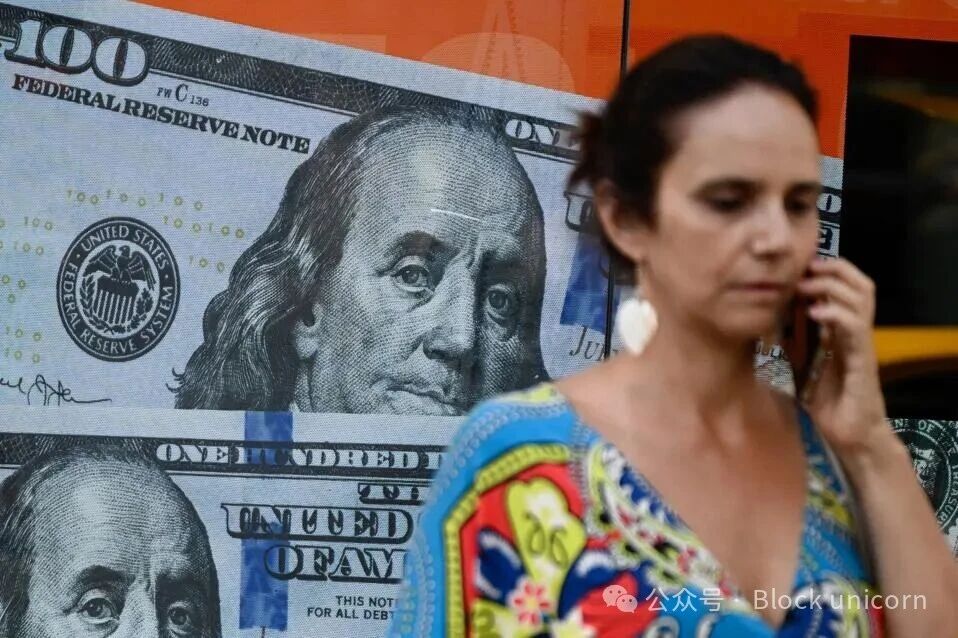Written by: Jeff Gapusan
Translated by: Block unicorn
As traditional finance (TradFi) faces challenges in responding to technological innovations and growing consumer demands, stablecoins have emerged as one of the most influential and controversial products. The United States (including policymakers and the private sector) has gradually recognized that stablecoins can serve as a powerful tool to fund the world's largest economy, with U.S. Treasury bonds being its safest financial instrument. A recent research report from Standard Chartered Bank pointed out that stablecoins could negatively impact the stability of financial institutions in developing countries, triggering large-scale deposit outflows and weakening the power of local central banks.

The story of stablecoins is evolving, potentially leading to two starkly different financial outcomes: the most enthusiastic users (emerging markets) may further undermine the economic infrastructure they are trying to protect their wealth, while simultaneously strengthening developed market enterprises.
Digital Dollarization: A $1 Trillion Stablecoin at Risk

In Buenos Aires, a woman walks past a billboard featuring a $100 bill. Argentinians typically exchange pesos for dollars to protect their savings from "hyperinflation." (Image source: LUIS ROBAYO/AFP via Getty Images)
From Argentina to Africa, exchanging currency for dollars is part of daily life. Stablecoins have greatly accelerated this process, providing a convenient digital channel for it.
For decades, citizens of countries with weak and unstable currencies have chosen to exchange their local currency for dollars or dollar-denominated assets. In Zimbabwe, which has suffered from years of hyperinflation and economic turmoil, about 85% of transactions are dollar-denominated. In other countries like Ecuador and El Salvador, the dollar has become their official currency.
The vast majority of stablecoin usage is concentrated in developing countries. In emerging markets, stablecoins are a necessity to withstand hyperinflation and unpredictable political crises.
In developed markets, stablecoins have become a fiat entry point for cryptocurrency trading, institutional settlements, or transitioning from bank deposits to digital assets. Users can leverage stablecoins to access alternative digital payment, financial, and investment means that can compete with many traditional financial solutions in terms of speed, efficiency, and cost.
These two use cases form a stark contrast. One might argue that these two positions concern the trade-off between financial advantages and actual needs.

Standard Chartered Bank has a wide business network, local market expertise, and focuses on cross-border trade and financial services, making it a pillar of banking in emerging markets in Asia, Africa, and the Middle East. (Image source: Matthew Lloyd/Getty Images)
Standard Chartered was the first to warn about the potential negative impacts of the stablecoin economy. According to a research report released in October, current trends suggest that by the end of 2028, up to $1 trillion in deposits could flow from emerging market banks to stablecoins. This wealth transfer is not merely theoretical; it could pose a profound threat to the credit systems of many countries.
Emerging Market Stablecoin Growth
The core driving force behind the growth of stablecoins in emerging markets is self-protection.
People want to preserve their hard-earned wealth. According to Standard Chartered, for citizens in countries facing hyperinflation or currency devaluation, "capital return is more important than capital return rate."

Like Germany during the hyperinflation period of 1923-1924, emerging markets are more focused on capital return rather than capital return. (Image source: Global History Archive/Getty Images)
Stablecoins provide a reliable, instant, and borderless means to store wealth linked to the dollar in digital wallets. When citizens liquidate their local currencies (such as the Turkish lira, Argentine peso, or Nigerian naira) to purchase stablecoins, the liquidity of these local currencies disappears from the domestic banking system. The consequences of this capital outflow are multifaceted and severe for local governments.
Fractional Reserve Banking System: The Traditional Financial Operating System

The fractional reserve banking system allows financial institutions to hold only a portion of deposit funds as reserves, facilitating economic expansion. This enables them to issue mortgages and auto loans to consumers. (Image source: Mario Tama/Getty Images)
The fractional reserve banking system is the dominant banking model globally. It allows banks to hold a certain percentage of customer deposits as reserves, while lending the remainder to borrowers. As commercial banks lose their cheapest and most reliable source of funding (retail deposits), their ability to provide credit to local businesses and consumers is constrained, leading to higher borrowing costs and suppressing domestic economic growth.
Monetary Policy Management

Central banks formulate monetary policy, thereby influencing their respective national economies. The seal of the U.S. Federal Reserve System (Image source: MANDEL NGAN/AFP via Getty Images)
Central banks rely on traditional tools (such as raising interest rates) to manage the money supply and curb inflation. However, when large amounts of local currency are exchanged for offshore dollar tokens, and these exchanges are not regulated by central banks, this traditional monetary policy transmission mechanism is severely weakened. Regulators will be unable to grasp the true scale of dollar flows and assess the effectiveness of their policy measures.
Accelerated Capital Outflow: Stablecoins vs. ATMs

In July 2015, the world witnessed Greek citizens queuing at ATMs across the country to withdraw their hard-earned savings. To prevent capital flight, the Greek government implemented capital controls. (Image source: Getty Images)
In July 2015, during the Greek debt crisis, images and videos of Greek citizens queuing at ATMs to withdraw their savings spread globally, marking the outbreak of this crisis.
Like the Greek debt crisis, the 1997 Asian financial crisis, and even the Silvergate incident or the collapse of Silicon Valley Bank, capital flight is often a precursor to an impending liquidity crisis. Stablecoins provide a seamless, around-the-clock avenue for capital to escape local currencies, which could accelerate exchange rate volatility and lead to bank failures. They have the potential to facilitate instantaneous digital capital flight, a situation that traditional regulatory mechanisms are ill-equipped to handle.
Countries identified as the most vulnerable include those with weak fiscal conditions and a high reliance on remittances, such as Egypt, Pakistan, Bangladesh, and Sri Lanka.
Financing U.S. Debt through Stablecoins
If $1 trillion potentially flows out of the developing world, where will this capital ultimately go?
The demand for stablecoins in emerging markets will inevitably lead to a demand for the safest collateral—U.S. Treasury bonds. This mechanism is key to the stablecoin paradox, effectively reinforcing the financial core of the United States.
Stablecoins, especially those designed to comply with regulatory requirements and achieve a 1:1 peg, must hold high liquidity, low-risk reserves. These reserves primarily consist of cash, cash equivalents, and short-term U.S. Treasury bonds.
Research from institutions like the Federal Reserve Bank of Kansas City highlights this crucial financial connection. As stablecoin development continues to deepen, its total market capitalization is expected to grow from over $300 billion currently to trillions of dollars within just three years, stimulating demand for U.S. short-term government bonds.
The Federal Reserve Bank of Kansas City noted in its analysis that while stablecoins may replace demand for other short-term instruments like money market funds, they will create a significant incremental demand for U.S. debt.
A New Anchor of Stability
As fiscal and monetary policies come under scrutiny, the growing demand for U.S. Treasury bonds will greatly benefit the United States. Research from the Federal Reserve confirms that stablecoins are not merely a cryptocurrency phenomenon but a vital new component of the U.S. government financing system.

The U.S. national debt clock tracks U.S. Treasury debt in real-time and its proportion in American households, vividly reminding people of the growing fiscal burden in the U.S. (Image source: Selcuk Acar/Anadolu via Getty Images)
The U.S. national debt has reached $38 trillion and is growing rapidly! The increasing demand for national debt will absorb massive U.S. government debt issuance while potentially helping to lower borrowing costs.

Shadow banking is often a pejorative term, but as financial institutions develop stablecoins, shadow banking may further proliferate. (Image source: Ernst Haas/Ernst Haas/Getty Images)
Ironically, the proliferation of stablecoins has fostered the spread of a term that is often avoided in banking—shadow banking. By mandating that reserve assets must possess extremely high quality and liquidity, regulators have effectively turned the digital asset industry into "captive investors" of U.S. debt.
Stablecoins Promote Strong Dollar Policies

As people around the world choose dollar-denominated stablecoins, the strength and importance of the dollar will increase. (Image source: Matias Baglietto/NurPhoto via Getty Images)
Each issuance of a dollar-denominated stablecoin effectively represents a vote of confidence in the dollar, reinforcing its status as the world's reserve currency. The digital infrastructure built by stablecoins makes it easier for people in other parts of the world to transact and save in dollars, further solidifying the dollar's global financial dominance during today's times of global financial turmoil.
Global Interconnectivity and Regulatory Challenges of Stablecoins

Global financial leaders must examine how to leverage stablecoin technology while avoiding potential negative impacts on the economies that rely most on stability. (Image source: Andrew Harnik/Getty Images)
The stablecoin market has created a direct and instantaneous channel for capital transfer: the risk-averse mentality in developing countries has driven an insatiable global demand for safe assets backed by U.S. Treasury bonds, especially in emerging markets.
When citizens exchange their local currencies for dollars to avoid the risks of inflation and economic instability, these exchanged funds ultimately enhance the financial strength of the United States. Dollar-denominated stablecoins can facilitate capital operations that the global financial system would typically take days to complete in just seconds.
While opening doors for those affected by hyperinflation and economic instability, the rapid growth of stablecoins also presents challenges for global financial regulators and banks, as they need to find ways to harness the advantages of stablecoin technology (cheaper cross-border payments and inclusive finance) without undermining the stability of the most vulnerable economies they serve.
免责声明:本文章仅代表作者个人观点,不代表本平台的立场和观点。本文章仅供信息分享,不构成对任何人的任何投资建议。用户与作者之间的任何争议,与本平台无关。如网页中刊载的文章或图片涉及侵权,请提供相关的权利证明和身份证明发送邮件到support@aicoin.com,本平台相关工作人员将会进行核查。




